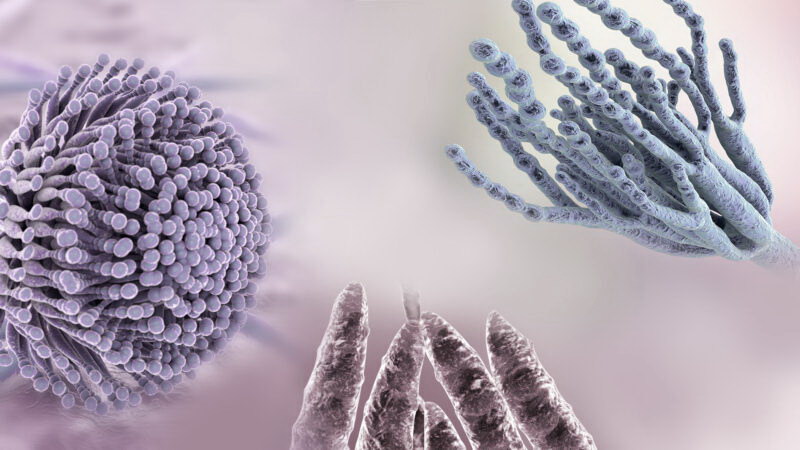Mycotoxins – a force to be reckoned with!
Mycotoxins

Mycotoxins are toxic substances originating from the secondary metabolism of different types of fungi such as Fusarium, Aspergillus and Penicillium. Mycotoxins are produced by fungi growing on crops in the field or during the storage of vegetable ingredients. Although the prevalence of mycotoxins can be region-specific due to climate and post-harvest storage conditions, mycotoxin contamination in food and feed is a worldwide problem.
Among hundreds of known mycotoxins, aflatoxins (AFs), ochratoxin A (OTA), fumonisins (FBs), zearalenone (ZEA) and trichothecenes (DON, T-2, HT-2) are considered the major mycotoxins in animal production. The variety of clinical effects caused by mycotoxins after ingestion ranges from reduced performance, suppressed immune function, organ damage, reduced gut health and nervous and reproductive system problems and depend on the type of mycotoxin, its dosage and the animal species. Significant economic losses are associated with mycotoxins due to their impact on animal performance.
Problems associated with mycotoxins in poultry, swine and ruminants
Poultry
- Immunosuppression
- Reduced feed intake
- Intestinal damage
- Liver damage
- Oral lesions
- Poor egg shell quality
- Poor feathering
- Fatty liver
- Kidney damage
- Residues in consumption eggs
Swine
- Immunosuppression
- Reduced feed intake
- Intestinal damage
- Liver damage
- Pulmonary edema
- Ear/tail necrosis
- Postpartum dysgalactia syndrome
- Fatty liver
- Kidney damage
- Reproduction problems
- Lameness
Ruminants
- Immunosuppression
- Reduced feed intake
- Intestinal damage
- Liver damage
- Decreased milk production
- Displaced abomasum
- Impaired rumen function
- Reproduction problems
- Lameness
- Residues in milk
Sampling
Mycotoxins cause diverse toxic effects on animals and for this reason, it is important to adopt good management and control practices to reduce their impact. These practices include correct sampling, fast and reliable analysis methods and taking appropriate measures based on the results. Sampling is one of the most crucial, but underestimated parts of the detection. Mycotoxins are not distributed homogeneously in the raw materials. Therefore, if representative samples are not taken from different parts of the bulk, the results will very possibly be negative for mycotoxins, generating a false sense of security.
Synergy
Another important point to keep in mind is the simultaneous presence of various mycotoxins in the raw materials. The presence of multiple mycotoxins can generate additive or synergistic effects, making the negative effect on health and production bigger than the sum of the individual effects. In addition, chronic exposure to low concentrations of mycotoxins results in non-specific symptoms which are difficult to track-and-trace down to mycotoxins. Consequently, the ingestion of multiple low-dose mycotoxins can result in more severe negative effects on animal performance and larger economic losses than an acute toxic dose.
Modified mycotoxins
Modified mycotoxins are derivatives of mycotoxins produced by fungi or formed by infected plants as part of their defense mechanism. In addition, the formation of these derivatives can also occur by feed production processes and by microbial metabolism. Once ingested with the feed, the modified mycotoxin can be reconverted to the parent toxin by the microbiota and metabolism of the animal. Modified mycotoxins often exhibit a similar toxicity as their parent toxins, but can also be less or even more toxic than their parent toxin. Modified mycotoxins are problematic as they are hidden from many analytical detection methods, leading to an underestimation of the contamination level of the feed.
Strategies to prevent the effects of mycotoxins
The most efficient approach to reduce the adverse effects of mycotoxins on production animals, is the use of substances that can reduce the absorption and promote the excretion of mycotoxins. Broad-spectrum mycotoxin binders are the most effective tool to counteract the effects of mycotoxins.
To prevent the effects of mycotoxins on animal performance, Nutrex developed the Starbind product range. The Starbind brand covers a variety of products, ranging from binders composed only of various carefully selected silicate-based components to more complex products with more diverse ingredients that act synergistically to prevent and counter the negative impact of mycotoxin contamination.
References are available upon request.
Contact us for more information!
